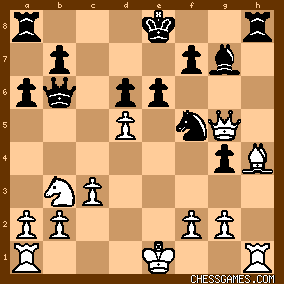| Jul-21-14 | | geeker: A very exciting game for the spectators! |
|
| Jul-21-14 | | capablancakarpov: One of the weirdest sicilians i´ve ever seen... |
|
| Jul-21-14 | | shintaro go: Wild game with a terrible finish |
|
Jul-22-14
 | | ketchuplover: agreed |
|
| Jul-22-14 | | Ulhumbrus: An alternative to 11 h4 is 11 h3 |
|
Jul-22-14
 | | PawnSac: < Ulhumbrus: An alternative to 11 h4 is 11 h3 > according to the CG opening database, four moves have been played here... 11. Nf5
11. Bxg4
11. h4
11. h3
statistically h3 is the poorest with no wins shown.
I suppose if one is going to play this line, move 11
would be the critical point to begin one's opening preparation. Opening Explorer |
|
Jul-22-14
 | | perfidious: While I am not at all familiar with this variation, the first idea after 11.h3 was 11....h4 12.hxg4 hxg3 13.Rxh8+ Bxh8. Don't like this at all, for the absence of the dark-squared bishop will soon be felt and White's position is full of weaknesses. K Wu vs I Stathopoulos, 2012 was a summary demolition as White's lack of development and the opponent's easy play on the dark squares made themselves apparent in short order. |
|
| Jul-22-14 | | Rookiepawn: 
click for larger viewDoesn't 20. Qxg4 lose a tempo here? Besides it allows Bf6. Seems like a pawn-grabbing move in the middle of a sharp game, leaving WQ in a bad square. I'd suggest 20. dxe6 followed by 0-0-0 and I think White is better. Is there a good reason behind Qxg4? |
|
| Jul-23-14 | | Ulhumbrus: <PawnSac: < Ulhumbrus: An alternative to 11 h4 is 11 h3 >
according to the CG opening database, four moves have been played here... 11. Nf5
11. Bxg4
11. h4
11. h3
statistically h3 is the poorest with no wins shown.
I suppose if one is going to play this line, move 11
would be the critical point to begin one's opening preparation. Opening Explorer
> 11 Nf5 looks attractive. It threatens not only the N on g4 but the h5 pawn as well, and 11...Bxf5 concedes the bishop psir. On 11 Nf5 Bxf5 12 exf5 h4 13 Bxg4 hxg3 removes White's bishop pair. On 14 fxg3 White has won a pawn but his e and f pawns have been displaced so that his g pawns are doubled. White's h pawn is backward but he may play h4. This warrants looking at further but at the very least the displacement of White's pawns has reduced the value of the pawn which he has gained. |
|
Jul-23-14
 | | Fusilli: <Rookiepawn> Watch out... Black has Bh6 against 0-0-0. Probably the reason why the queen has to be removed from g5. |
|
| Jul-23-14 | | Rookiepawn: <Fusilli: <Rookiepawn> Watch out... Black has Bh6 against 0-0-0. Probably the reason why the queen has to be removed from g5.> Geez, I need a better eye, thanks.
But still 20. dxe6 seems better to me, if taking the WQ off the dangerous diagonal is the issue then 20. dxe6 fxe6
21. Qg6+
Does the same without losing a tempo. The WB is hanging, like in the game variant, but 22. g3 is possible. A dizzy position anyway! |
|
Jul-24-14
 | | Fusilli: <Rookiepawn> That looks fine, although technically you are not saving a tempo because the g4 pawn is still there. It's a complicated position, very tactical. If you play g3 then the 0-0-0 gets delayed and I wonder if that's a problem. Black has a more exposed king, but it seems unclear if that can be exploited. And the white bishop is pinned. Maybe we should ask the engine. This is the kind of position they "like". |
|
Nov-05-15
 | | fredthebear: What about 21.BxBf6!? offering Black the double rook sacrifice for the opportunity to play Qg8+, Qxf7+, etc. Looks like it just might be playable, as White goes double down the exchange but w/lasting pressure on the Black king, conceding some exposure for the White king as well. Black can insert a check in the sequence, but I think White can answer it and get back the initiative.
How do the computers refute 21.BxBf6!? |
|





